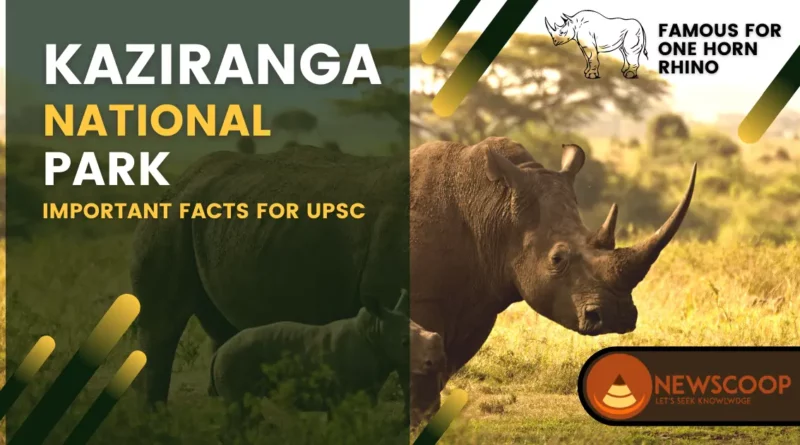Kaziranga National Park in Assam: Key Facts for UPSC
Kaziranga National Park is a protected area located in the northeastern state of Assam, India. It covers an area of 430 square kilometers and is known for its large population of one-horned Indian rhinoceroses. In fact, Kaziranga is home to over two-thirds of the world’s population of this endangered species.
The park is located on the edge of the Brahmaputra River floodplain and is surrounded by the Karbi Anglong hills to the south and the Nagaland hills to the north. The terrain is characterized by tall elephant grass interspersed with swamps and narrow strips of the forest.
Kaziranga is also home to many other species of wildlife, including elephants, tigers, wild water buffalo, swamp deer, and various species of birds. In addition, the park is an important breeding ground for several species of migratory birds that visit during the winter months.
| National Park | Kaziranga |
| Founded in | 1974 |
| Location | Assam |
| World Heritage Site | in 1985 |
| Tiger Reserve in | in 2006 |
| Area Cover | 430 sq. km |
| Important Species | One-Horn Rhino |
Kaziranga National Park
Kaziranga National Park is located in the State of Assam and covers 42,996 hectares of land and has a total tiger reserve area of 1,030 sq km with a core area of 430 sq. km. Moreover, it is the single largest undisturbed and representative area in the Brahmaputra Valley floodplain.
Location of Kaziranga National Park
If we talk about the location, then Kaziranga National Park is situated in the middle of Golaghat District and Nagaur District, which are in the state of Assam. Further, if we talk about hotspots, then there are four hotspots in India and Kaziranga National Park lies in one of these hotspots.
History of Kaziranga National Park
- In 1905, Lord Curzon declared this area a protected area and in 1950 it was named Kaziranga Wildlife Sanctuary.
- In 1974, it was declared a National Park.
- In 1985, UNESCO declared Kaziranga National Park a World Heritage Site, due to its huge biodiversity.
- In 2006, when the Indian government saw that the tiger population was falling, the Indian government declared it a tiger reserve.
Also Read: Important Facts of Kanha National Park
Important Facts of Kaziranga National Park
- High Density of flora and fauna.
- High Species Diversity
- Highest Species Visibility.
- It is recognized as an Important Bird Area by BirdLife International.
- National Highway 37 passes through Kaziranga.
- Important Rivers:
- The park area is circumscribed by the Brahmaputra River, which forms the northern and eastern boundaries.
- Further, Mora Diphlu forms the southern boundary.
- Other notable rivers within the park are the Diphlu and Mora Dhansiri.
- Kaziranga contains significant breeding populations of 35 mammalian species.
- Kaziranga has the largest population of Wild water buffalo anywhere accounting for about 57% of the world’s population.
- It is the home of the world’s most one-horned rhinos.
- Much of the focus of conservation efforts in Kaziranga is focused on the ‘big four‘ species- Rhino, Elephant, Royal Bengal tiger, and Asiatic water buffalo.
- The world’s highest population density of tigers is found here.
- The most essential Rhino Species in the world is found here. Further, it hosts 2/3rd the population of the world’s One-Horn Rhino.

Asian Rhinos
Three Species of Asian Rhinos:
- Indian Rhino/ One-Horn Rhino– Largest among all Species of Rhinos and these are Vulnerable.
- Javan Rhino– are Critically Endangered.
- Sumatra Rhino– Only founded in Indonesia and are Critically Endangered.
Asian Rhino Range Countries:
- India
- Nepal
- Indonesia
- Malaysia
- Bhutan
List of Important Species in Kaziranga National Park
- Royal Bengal Tiger
- Asiatic Elephant
- Asiatic water buffalo
- One Horn Rhino
- Bar Headed Goose
- Spot Billed Pelican
- Northern Lapwing
- Asian Openbill
Also Read: Panna National Park
Government Initiatives to Protect Rhinos
- Special Rhino Protection Force: Special Rhino Protection Force has been created here by the Assam Government, which deals with the issues of hunting and poaching.
- Indian Rhino Vision 2020: Indian Government and WWF together, have released a document that has increased awareness and has talked about increasing the population of rhinos to 3000 in coming years.
So, this is all about Kaziranga National Park. If you like this article, please share it with your friends.
Thank You!
Related Links:


Excellent insights on UPSC preparation and its relevance